The illegal introduction of lake trout into Yellowstone Lake has had a marked impact on the lake's drainage, but also on neighboring basins across the entirety of Yellowstone National Park and surrounding public lands, according to a new scientific report produced by Yellowstone's lead fisheries biologist and a host of researchers who gathered data dating back to the mid-1990s.
According to the published report "Predatory fish invasion induces within and across ecosystem effects in Yellowstone National Park," predators that would normally feed on native Yellowstone cutthroat trout are now feeding on other prey, like elk calves and waterfowl, or they're leaving the Yellowstone Lake basin completely in search of accessible fish elsewhere. The report, led by Dr. Todd Koel, head of the park's Native Fish Conservation Program, demonstrates how the severe decline of native cutthroat trout due to predation from non-native lake trout has essentially rewired the park's intertwined ecosystem.
Yellowstone cutthroat trout were historically available to a host of park predators, including grizzly and black bears, bald eagles, osprey, otters and even coyotes, foxes and wolves. But, by 2010, lake trout had literally eaten away at the native cutthroat population, causing the loss of about 90 percent of all Yellowstone cutthroats in Yellowstone Lake. With these fish no longer swimming in the lake's shallows or running into tributary streams to spawn in the spring, bears and other predators were forced to adjust their diets.
Lake trout are not suitable replacements for native Yellowstone cutthroat trout as a prey base. Lakers spend most of their time in deeper water, unavailable to raptors like eagles and osprey, and they spawn in the lake, not in the lake's tributaries, where grizzlies and other terrestrial predators can't get to them. Even when they're in shallower water right after ice-out in the spring and again in the fall during spawning season, lake trout are not a readily available food source for park predators.
Lake trout, terrestrial predators and elk
Parts of the new report echo a July 2013 report, claiming grizzly bears had begun feeding on more terrestrial prey, and have likely focused in on elk calves. The area surrounding Yellowstone Lake is summer habitat for thousands of elk, some of which migrate out of the park in the winter to places like the National Elk Refuge near Jackson, Wyo., to lower-elevation public lands near Cody, Wyo., and to the Lamar Valley in Yellowstone's northern reaches.
The northern range elk herd, which uses the Lamar Valley, is probably the most monitored in the park and likely the most viewed by visitors. According to the National Park Service, Yellowstone provides suitable habitat for anywhere between 10,000 and 20,000 elk. Prior to 1995, the northern herd, by itself, had about 19,000 elk.
In 1995, wolves were reintroduced to the park and, a year earlier, the first lake trout was discovered in Yellowstone Lake. By the mid-2000s, the northern range herd had dropped down below 10,000, and in the winter of 2015-2016, the herd's numbers hovered around 5,000.
South of Yellowstone near Jackson, the National Elk Refuge hosts about 8,000 wintering elk every year, but in recent years, the numbers of "short-distance" migrant elk have increased on the refuge, while the numbers of elk moving south out of Yellowstone National Park has actually decreased.
Whether the drop in elk numbers in both the Lamar Valley and in Yellowstone migrants to the National Elk Refuge can be attributed to increased bear predation (in addition to historically normal predation from wolves) is anybody's guess. If timing is any indication, here's a nugget that might offer some insight: the winter count of the northern range herd in 2013 was below 4,000 for the first time in 45 years. By the winter of 2016, the herd's numbers increased to about 5,000. Granted, there are lots of factors at play in elk population numbers, but as park contractors were removing between 300,000 and 400,000 lake trout from Yellowstone Lake every year starting in 2012, and an uptick in spawning cutthroat trout was recorded, the population of the northern herd elk has trended upward, too.

Koel noted that, in recent years, as native cutthroat have begun to spawn again in Yellowstone Lake tributaries, grizzlies have again been observed feeding on spawning trout, particularly around Grant Village on the West Thumb of the lake.
The new report also mentions that bald eagles, which used to feed on shallow-swimming and migrating cutthroat trout, are now targeting trumpeter swan cygnets, young white pelicans and the young of other waterfowl, like cormorants, gulls, geese and ducks because cutthroat trout aren't as abundant as they used to be. The eagles are also scavenging more on dead animal carcasses, and, for the nesting pairs that still use the lake, nesting success has been down for some time.
Osprey have all but abandoned Yellowstone Lake, and the few remaining nesting pairs leave the lake and travel as much as five air miles away to pursue cutthroat trout in other drainages.
"It's interesting, because the number of bears hasn't really fallen off," said Koel, who teamed up with fellow National Park Service researchers and researchers from both the University of Wyoming and Montana State University to complete the report. "They've been able to find alternative food sources. But osprey—they haven't been feeding on cutthroat trout in the lake for quite a while."
The link among lake trout, bears and elk was first established in that 2013 report. That report noted that, in the 1980s, 12 percent of the young elk killed in Yellowstone fell victim to grizzlies and, to a lesser extent, black bears. By the mid-2000s, at the height of the lake trout infestation (23 years of netting has finally started to knock lake trout numbers back in Yellowstone Lake), 41 percent of the young elk killed in the park were killed by bears.

It's all in the net
As noted, lake trout were first discovered in Yellowstone Lake in 1994. By 1995, the report estimates, there were about 125,000 lake trout—ages 2 and over—in Yellowstone Lake. By 2012, that number was just shy of a million non-native lake trout, despite gillnetting efforts between 1995 and 2012 that removed more than 1.1 million fish from the lake.
"We definitely slowed the population growth over the years," Koel said, "but until recently, we didn't stop the growth or reduce it."
Netting has been a $2 million-a-year effort by the Park Service since 2012, thanks to an annual grant of $1 million from Yellowstone Forever (formerly the Yellowstone Park Foundation) and a $1 million match from the NPS. Early in the process, both box nets and gillnets were used in the lake to remove lake trout. The effort now is almost solely focused on gillnetting. Each year until 2017, about 300,000 lake trout were removed. Things got a bit discouraging, Koel said, in 2017, when the lake trout catch rate increased to about 400,000.
"Then last year, in 2018, we dropped back down to 300,000 fish, and there was more effort put into it," he said. That's encouraging news, Koel said, and one of the first real substantive signs that the netting was paying off in terms of long-term lake trout suppression. "When your catch rate declines by 25 percent in a single year, and you put more effort into into, that's a good thing."
Overall, the report notes, between 1995 and 2017, nearly 3 million lake trout were removed from Yellowstone Lake. Only in recent years has the removal effort resulted in an uptick in Yellowstone cutthroat trout populations. Recovery of the native fish, however, is contingent upon the continued removal and control efforts targeting invasive lake trout, which are native to the Great Lakes and Canada.
Even though cutthroat recovery appears to be under way, park biologists have not documented an immediate return to the historic food web. As noted above, there are some bears keying in on smaller tributary streams to the lake near Grant Village that are now seeing renewed cutthroat trout spawning runs, but, overall, there don't appear to be many ecological changes to the muscle memory developed by park predators over the last few decades.
"That's the hope, that things will get back to normal," Koel said. "We're seeing more younger cutthroats in the lake, so that's a sign that there's been some spawning success.
"I think, when we start to see osprey coming back to the lake, that will be a big deal," Koel continued. "That will be a hopeful sign that things are getting back to normal."
The little critters matter, too
The lake trout invasion has changed the lake's makeup down to the microscopic level. For instance, without cutthroat trout to feed on small zooplanktons—tiny crustaceans like water fleas and very small shrimp—in the lake, the populations of larger-bodied zooplanktons resulted in clearer water and, as a result, warmer water temperatures, the report notes. Temperature increases of nearly half a degree Celsius near the surface have been reported.
Also, the loss of migratory cutthroats into the lake's spawning tributaries has drastically reduced the transport of nutrients like ammonium from the lake into the streams.
"When you don't have that nutrient transfer, the effects on lower trophic levels in the streams is imminent," Koel said, referring to the spawning streams' aquatic insect life that is needed to nurture young trout before the migrate out to the lake. "It kind of creates a negative feedback loop, and we don't know how long it will take these streams to recover at that level."
What's next for Yellowstone Lake
The netting will continue, Koel says. Just this year, the Park Service signed another 5-year contract with a netting contractor from Wisconsin, the same outfit that has worked on Yellowstone Lake for years.
"It's pretty amazing what they do," Koel said. "There are about 40 miles of net in the lake on any given day during the season."

But, in recent years, netting is only part of the effort.
Park Service biologists have identified 14 spawning sites throughout the lake using telemetry equipment and "Judas fish" implanted with transmitters. The telemetry equipment was purchased with money from Trout Unlimited volunteers all across America who responded to requests for cash from TU councils in Wyoming, Montana and Idaho.
Data from the Judas fish provides vital information about lake trout movement through the lake and, more importantly, where the lake trout spawn every fall. For a few years now, the Park Service has been depositing the carcasses of netted lake trout over spawning beds when eggs are present. The decaying fish break down and smother the eggs, robbing the water near the spawning redds of oxygen. This eventually kills the eggs.
"It's just another method we're using to try and knock lake trout numbers back," Koel said.
But it's also problematic. By fall, when lake trout are spawning, netting operations are slowing down in preparation for cold weather and, eventually, ice. This leaves the Park Service with a shortage of dead lake trout to drop over spawning redds.
So, last year, Koel and his team tested a new method, using pellets made of soy and gluten plant matter to place over spawning redds. The idea is the same—the pellets break down and decay, stealing oxygen that lake trout eggs need for survival.
"Within a few days, the pellets break down and dissipate, and the area looks just like it did before," Koel said.
Targeting lake trout spawning redds is an effort, Koel said, to be more efficient when it comes to controlling and reducing lake trout numbers in Yellowstone Lake.
"The whole idea is to eventually be able to back off the netting, be more strategic and make the effort more affordable," he said.
Lake trout, as noted, are fall spawners. By the end of September, Koel said, the effort to go after the eggs on spawning redds ramps up. And, with only 14 known spawning redds in the lake (about .03 percent of the lakes entire 136 square miles of surface area), it's much easier to target the invasive fish when they congregate to mate.
This coming October, Koel said, the Park Service will scatter the oxygen-stealing pellets via helicopter over the known spawning redds.
"I think this is a really important effort," he said. "It's our best hope for long-term control, because there really aren't any egg-eating predators in the lake to speak of."
The future
While the new report offers up a somewhat gloomy perspective on how invasive lake trout have had a significant trickle-down impact on all of Yellowstone, there is hope thanks to the ongoing effort to suppress the exotic fish, that things can again get back to "normal."
As Koel notes, despite the loss of about 90 percent of the native Yellowstone cutthroat trout in Yellowstone Lake by 2010, there's an uptick in cutthroat numbers today. And, as netters work harder to catch fewer lake trout, optimism is abundant.
"We don't want to just knock the lake trout down," Koel said. "We want to punch their lights out."





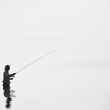

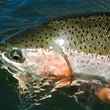



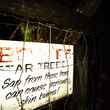




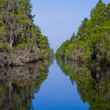
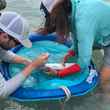



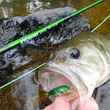
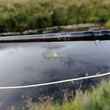



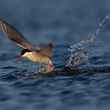




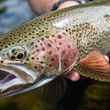
Comments